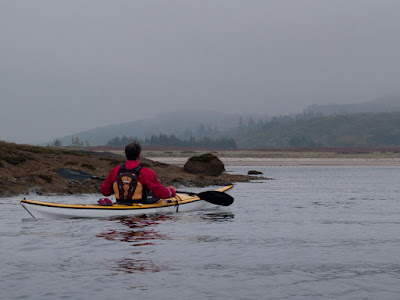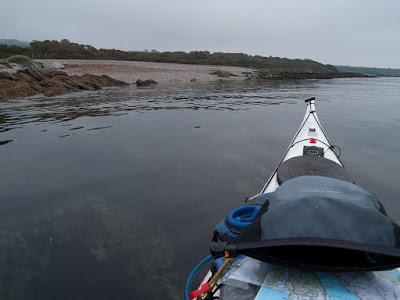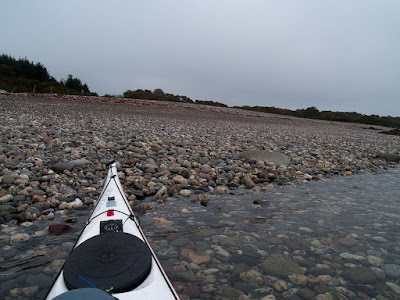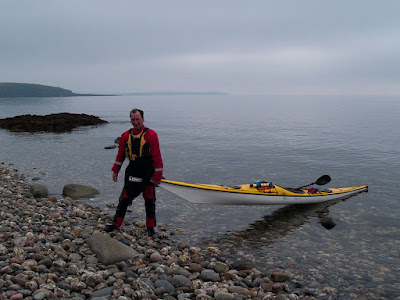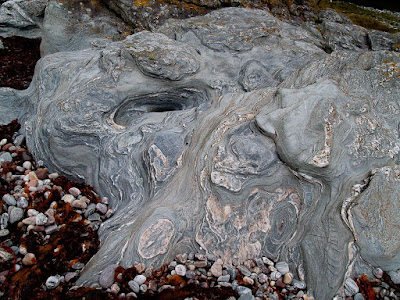From Asgog Bay, Mike and I took a little detour...
...round the island of Sgat Mor and its little lighthouse before turning north into the mouth of Loch Fyne, the biggest sea loch in Britain,...
...towards Portavadie Marina where we had...
...booked lunch for 12:30. The marina is the largest man made hole in the World. It was made to construct giant...
...concrete oil rigs even bigger than this one at nearby Ardyne, which I photographed when it was near complete in 1977.
The huge dock cost £14 million to excavate in the late '70s but by the time it was completed the industry had moved on to cheaper steel rigs. Portavadie never built a single rig! For a while it was used by a fish farm but it has been home to the excellent Portavadie Marina for quite a few years now. The hole is so deep that the marina proudly boast "There is no restriction on draft"
We paddled to the head of the marina and there we met David and Phil. We had originally planned a trip to Islay or Tiree but last minute commitments meant David and Phil could only manage 2 days and one night. Mike and I then decided to go for a more local paddle so that David and Phil could join us.
Where better to meet than the Portavadie Marina restaurant and bar? No restriction on draft? We can test that. We'll start with four pints of Guinness please.
We decided to go for a two course dinner and I started with the Taste of “Argyll Smokery” seafood and shellfish, pickled vegetables, watercress and wasabi cream. Service was excellent, so what a great second luncheon, highly recommended.Yes, sea kayaking can be a most arduous activity when one can be exposed to great hardships.
Some considerable time passed before we set off once more on our sea kayaking exploration of Argyll's secret coast.
Imagine you are at the edge of the sea on a day when it is difficult to say where the land ends and the sea begins and where the sea ends and the sky begins. Sea kayaking lets you explore these and your own boundaries and broadens your horizons. Sea kayaking is the new mountaineering.
Showing posts with label Loch Fyne. Show all posts
Showing posts with label Loch Fyne. Show all posts
Wednesday, July 15, 2015
Saturday, May 03, 2014
Spring in Kintyre.
From Ardlamont Point we paddled across the mouth of Loch Fyne in...
,,,glassy calm conditions.
The only thing that threatened our equilibrium was this fast speed boat which came weaving down the loch at high speed towards us. Ian hailed it three times on the VHF. There was no answer but to the helmsman's credit he dropped the boat off the plane and passed well clear of us.
It was getting hotter as we approached Kintyre but we spotted the white shingle beach of...
...Croit Bagh. It was such a relief to hear the crunch of shingle on the keel and get my stiff and sore knees out for a stretch!
It was time for first luncheon which was washed down with some of Ian's 15 year old Dalwhinnie.
After lunch I went for a short walk. The bed rocks which plunged into the sea on either side of the beach were composed of...
contorted schist. Above the rocks, the hillside was a beautiful...
...mixed deciduous woodland. Birch, alder oak and willow were all bursting into bud and the air was filled with the song of chiff-chaffs, willow warblers and a solitary cuckoo.
Beneath the burgeoning canopy primroses had burst into flower. Althougth at first glance all primroses look the same there are actually two subtypes called pin and thrum. These are pin. All primroses have both male and female flower parts but they are arranged differently. In the pin form the stigma is at the mouth of the flower tube and in the thrum form the anther is at the mouth of the flower tube. As primroses are insect pollinated, this ensures that pin pollen tends to fertilize thrum flowers and vice versa.
Behind the beach this delightful stream emerged from the woodland behind the beach. I filled my flask but I always boil such water and never drink it directly.
,,,glassy calm conditions.
The only thing that threatened our equilibrium was this fast speed boat which came weaving down the loch at high speed towards us. Ian hailed it three times on the VHF. There was no answer but to the helmsman's credit he dropped the boat off the plane and passed well clear of us.
It was getting hotter as we approached Kintyre but we spotted the white shingle beach of...
...Croit Bagh. It was such a relief to hear the crunch of shingle on the keel and get my stiff and sore knees out for a stretch!
It was time for first luncheon which was washed down with some of Ian's 15 year old Dalwhinnie.
After lunch I went for a short walk. The bed rocks which plunged into the sea on either side of the beach were composed of...
contorted schist. Above the rocks, the hillside was a beautiful...
...mixed deciduous woodland. Birch, alder oak and willow were all bursting into bud and the air was filled with the song of chiff-chaffs, willow warblers and a solitary cuckoo.
Beneath the burgeoning canopy primroses had burst into flower. Althougth at first glance all primroses look the same there are actually two subtypes called pin and thrum. These are pin. All primroses have both male and female flower parts but they are arranged differently. In the pin form the stigma is at the mouth of the flower tube and in the thrum form the anther is at the mouth of the flower tube. As primroses are insect pollinated, this ensures that pin pollen tends to fertilize thrum flowers and vice versa.
Behind the beach this delightful stream emerged from the woodland behind the beach. I filled my flask but I always boil such water and never drink it directly.
Wednesday, January 08, 2014
Sea kayaking desktop wallpaper calendar 2014.
I wish a very Happy New Year and a great 2014 paddling season to all visitors to seakayakphoto.com. As way of a celebration of the last year and in anticipation of sea kayaking adventures yet to come, here is the 10th annual sea kayaking desktop wallpaper calendar from seakayakphoto.com. I apologise for its late arrival. Neither my computer nor myself have been in the best of health.
As in past calendars, all the photos were taken during the previous year (2013). Unfortunately I have not been paddling over the last 6 months so the choice of photos has been more limited than previous years. Nevertheless I have been able to choose photos from north and south of Ardnamurchan Point, the Inner Hebrides, the North Channel, the Firth of Clyde and the Solway Firth.
Link to 8:5 desktop 1920 x 1200.
Link to 4:3 desktop 2048 x 1540.
Link to 8:5 desktop 1920 x 1200.
Link to 4:3 desktop 2048 x 1540.
mouth of the the Kyles of Bute.
As in past calendars, all the photos were taken during the previous year (2013). Unfortunately I have not been paddling over the last 6 months so the choice of photos has been more limited than previous years. Nevertheless I have been able to choose photos from north and south of Ardnamurchan Point, the Inner Hebrides, the North Channel, the Firth of Clyde and the Solway Firth.
January.
The Little Cumbrae lighthouse in the Firth of Clyde proved surprisingly popular despite being in the depths of winter. We met friends from the Drumchapel and Clydebank Kayak Club there.Link to 8:5 desktop 1920 x 1200.
Link to 4:3 desktop 2048 x 1540.
February.
Rubha Carrach is on the exposed northern coast of Ardnamurchan. This coast is not paddled as often as it should be. Most circumnavigators of the British mainland cross to Eigg or Rubh' Arisaig on their headlong dash north. Paddlers staying in the area are faced with a circumnavigation of the whole Ardnamurchan peninsula if they only have one car, or a very long shuttle (over very slow single track) if they have two cars.Link to 8:5 desktop 1920 x 1200.
Link to 4:3 desktop 2048 x 1540.
March.
Glenuig Bay opens into the Sound of Arisaig and views extend along the Ardnamurchan peninsula and to Muck and the other Small Isles. One of the great joys of winter paddling is returning in the dark!
April.
The north coast of Rum in the Sea of the Hebrides is a wild place. This is the sad wreck of the Jack Abry II, a French trawler that ran on to the rocks here just before midnight on the 31st January 2011. Fortunately, despite a gale and the surrounding cliffs and mountains, all 14 men on board were airlifted to safety by the Stornoway coastguard helicopter.
May.
The Mull of Kintyre is a rather committing paddle. The tide was moving at 6 knots and even in benign conditions there was no landing for 25km. It sticks out into the North Channel which separates Scotland from Ireland. On this misty day there was no sign of Ireland and we felt like we were paddling round the edge of the World.
Link to 8:5 desktop 1920 x 1200.
Link to 8:5 desktop 1920 x 1200.
July.
Murray's Isles lie in the mouth of Fleet Bay on the Solway Firth. In early summer they host noisy colonies of cormorants and gulls. The cormorants need to keep a watchful eye on their eggs and chicks as the gulls swoop down on any unguarded nest. It is a wonderful experience to drift in the tide past the colonies in kakak and watch, hear and smell the constant activity.
September.
The surf beach at Machrihanish is exposed to the North Atlantic swell and extends for over 6 kilometers. It is probably wise not to surf a fully laden sea kayak in amongst the surfers. The dune system behind the beach is one of the largest in Scotland.
October.
Shoe Bay is easily missed as it is hidden in the skerries at the mouth of Loch Moidart. The name comes from the very soft sand which swallows footwear!
November.
The dramatic outline of An Sgurr is the highest point of Eigg in the Sea of the Hebrides.
Link to 8:5 desktop 1920 x 1200.
Link to 8:5 desktop 1920 x 1200.
December.
This is the view to the Small Isles from the silver sands of Morar Bay. The bay is shallow and tidal and in a westerly wind, steep breaking waves build up as the ebb tide rushes over sandbars. On this trip the wind was from the east and all was calm.
Link to 8:5 desktop 1920 x 1200.
Link to 8:5 desktop 1920 x 1200.
Monday, September 09, 2013
Tired kayakers and concrete sleepers at Kilbride Bay.
From Skate Island we enjoyed a fast reach eastwards along the Ardlamont peninsula, which divides Loch Fyne from the Kyles of Bute. The cool clear air of the north wind and the low evening sun made for a breathtaking view over the Sound of Bute to Arran. We passed dolphins, porpoises, otters, puffins and diving gannets. It was difficult to believe that this glorious wilderness was in the Firth of Clyde, in the catchment area of which, 3/5 of Scotland's population live.
Many sea kayaking visitors to Scotland (and also many Scottish sea kayakers) tend to shun the Firth of Clyde and head north to places like Arisaig and the Summer Isles. Maybe the above photos might cause some wilderness seekers to think again.
View Larger Map
At the east end of the beach, a railway line with concrete sleepers still runs straight down into the sea...
Many sea kayaking visitors to Scotland (and also many Scottish sea kayakers) tend to shun the Firth of Clyde and head north to places like Arisaig and the Summer Isles. Maybe the above photos might cause some wilderness seekers to think again.
The Ardlamont peninsula holds a glorious little visited beach that you can only visit by walking in or by boat. It is Kilbride Bay. It has a huge crescent of sand backed by dunes and machair.
We landed at its western end and had a well earned break while enjoying the view. However, unspoiled though Kilbride Bay appears, it was heavily used in WW2 for army, air force naval training exercises.
View Larger Map
At the east end of the beach, a railway line with concrete sleepers still runs straight down into the sea...
Friday, September 06, 2013
Paddle sailing away in the clear air at the end of a long day.
Once we left the shelter of East Loch Tarbert we entered the wide mouth of Loch Fyne, which is the longest sea loch in the Firth of Clyde and indeed the whole of Scotland. The view out of the loch across the expanse of the Sound of Bute to the rocky ridges of the Arran mountains was stunning. As we entered open waters a breeze picked up and we hoisted our sails.
After some exhilarating paddle sailing in the wonderful clear evening light we...
...reassembled by the Skate Island (Sgat Mor) lighthouse.
I think Phil's smile will save any lengthy further description of the crossing!
Monday, March 28, 2011
Death in Ardlamont.
We paddled towards the mouth of Loch Fyne along a raised beach until we came to...
...Kilbride Bay. The sad remains of a dead whale lay beached on the shore. The smell of death hung so heavy in the air that we could not approach closer to investigate its species. We paddled over huge detatched ribs with flesh still attached, that lay under the clear waters below its final resting place.
The whale is not the only death that has attracted attention in Ardlamont. This is the boathouse of Ardlamont estate, tradtional home of the Lamont clan. The boathouse has a dark secret. In 1893, Alfred Monson, a gentlemen’s tutor, rented the estate to give 17year old Cecil Hambrough a Scottish country experience. Monson persauded Hambbrough to take out a life insurance policy for £20,000 with his wife as the sole beneficiary. He then set out to murder the boy and claim the insurance. He took the boy, who could not swim, fishing in the bay. He had earlier drilled a hole in the bottom of the boat. The boat sank and Monson reached the shore without difficulty. The desperate boy learned to swim and thrashed his way to the shore. The next day Monson took the still unsuspecting boy shooting in the woods and shot him. He claimed the boy had shot himself. In a notorious trial, the jury found the murder charge against Monson "not proven" and he walked free but with his reputation in tatters. Five years later he went to jail for insurance fraud.
As we approached Ardlamont Point the mist thickened...
and it was impossible to say where the sea ended and the sky began.
We turned our gaze downward and were rewarded with views of Ardlamont's submerged reefs lying beneath the calm clear waters.
...Kilbride Bay. The sad remains of a dead whale lay beached on the shore. The smell of death hung so heavy in the air that we could not approach closer to investigate its species. We paddled over huge detatched ribs with flesh still attached, that lay under the clear waters below its final resting place.
The whale is not the only death that has attracted attention in Ardlamont. This is the boathouse of Ardlamont estate, tradtional home of the Lamont clan. The boathouse has a dark secret. In 1893, Alfred Monson, a gentlemen’s tutor, rented the estate to give 17year old Cecil Hambrough a Scottish country experience. Monson persauded Hambbrough to take out a life insurance policy for £20,000 with his wife as the sole beneficiary. He then set out to murder the boy and claim the insurance. He took the boy, who could not swim, fishing in the bay. He had earlier drilled a hole in the bottom of the boat. The boat sank and Monson reached the shore without difficulty. The desperate boy learned to swim and thrashed his way to the shore. The next day Monson took the still unsuspecting boy shooting in the woods and shot him. He claimed the boy had shot himself. In a notorious trial, the jury found the murder charge against Monson "not proven" and he walked free but with his reputation in tatters. Five years later he went to jail for insurance fraud.
As we approached Ardlamont Point the mist thickened...
and it was impossible to say where the sea ended and the sky began.
We turned our gaze downward and were rewarded with views of Ardlamont's submerged reefs lying beneath the calm clear waters.
Saturday, March 26, 2011
Clear seas full of sprats, off Ardlamont Point
The Cowal peninsula has some really great bays. This is Kilbride Bay, which was very atmospheric with the mist lying low over the hills and forests.
Off Rhuba na Peileig the sea was boiling with large shoals of sprats.
Just round the point, we came across this lovely...
...beach of cobbles.
It was now time for our first luncheon.
We sat on these wonderful whorled rocks. I found a very nice mask, snorkel and gloves here, so if you have lost them drop me a line.
After lunch we walked up onto a huge raised beach that stretched away to Ardlamont Point in the distance. The dark patches on the water below the horizon are large shoals of sprats.
Off Rhuba na Peileig the sea was boiling with large shoals of sprats.
Just round the point, we came across this lovely...
...beach of cobbles.
It was now time for our first luncheon.
We sat on these wonderful whorled rocks. I found a very nice mask, snorkel and gloves here, so if you have lost them drop me a line.
After lunch we walked up onto a huge raised beach that stretched away to Ardlamont Point in the distance. The dark patches on the water below the horizon are large shoals of sprats.
















































